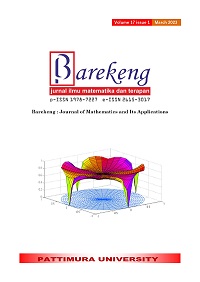ALTERNATIVE PROOF OF THE INFINITUDE PRIMES AND PRIME PROPERTIES
Abstract
Prime numbers is one of kind number that have many uses, one of which is cryptography. The uniqueness of prime numbers in their divisors and distributions causes prime numbers to be widely used in digital security systems. In number theory, one of famous theorem is Euclid theorem. Euclid theorem says about infinitely of prime numbers. Many alternative proof has been given by mathematician to find new theory or approximation of prime properties. The construction of proof give new idea about properties of prime number. So, in this study, we will give an alternative proof of Euclid theorem and investigate the properties of prime in distribution.
Downloads
References
Sukirman, Logika dan Himpunan. Yogyakarta: Hanggar Kreator, 2006.
V. B. K. Olsen, V. B. K. Olsen, and W. Thrush, “Avian Insectivores Respond to 17-year Brood X Periodical Cicada Emergences Hypothesis : Avian insectivores show a positive numerical Discussion : This,” in University of Maryland Graduate Research Interaction Day, 2007, no. Aprill.
D. B. Ginting, “Peranan Aritmetika Modulo dan Bilangan Prima pada Algoritma Kriptografi RSA (Rivest-Shamir-Adleman),” Media Inform., vol. 9, no. 2, 2010.
P. Chaudhury et al., “ACAFP: Asymmetric key based cryptographic algorithm using four prime numbers to secure message communication. A review on RSA algorithm,” in 2017 8th Annual Industrial Automation and Electromechanical Engineering Conference (IEMECON), 2017, pp. 332–337.
G. Iovane, C. Bisogni, L. De Maio, and M. Nappi, “An encryption approach using information fusion techniques involving prime numbers and face biometrics,” IEEE Trans. Sustain. Comput., vol. 5, no. 2, pp. 260–267, 2018.
V. Maksymovych, O. Harasymchuk, M. Karpinski, M. Shabatura, D. Jancarczyk, and K. Kajstura, “A new approach to the development of additive Fibonacci generators based on prime numbers,” Electronics, vol. 10, no. 23, p. 2912, 2021.
W. S. Kendal and B. Jørgensen, “A scale invariant distribution of the prime numbers,” Computation, vol. 3, no. 4, pp. 528–540, 2015.
S. Kristyan, “On the statistical distribution of prime numbers: A view from where the distribution of prime numbers are not erratic,” in AIP Conference Proceedings, 2017, vol. 1863, no. 1, p. 560013.
M. Wolf, “Nearest-neighbor-spacing distribution of prime numbers and quantum chaos,” Phys. Rev. E, vol. 89, no. 2, p. 22922, 2014.
S. H. Marshall and D. R. Smith, “Feedback, control, and the distribution of prime numbers,” Math. Mag., vol. 86, no. 3, pp. 189–203, 2013.
M. El Boujnouni, “A study of prime numbers distribution based on support vector domain description,” J. Inf. Optim. Sci., vol. 42, no. 4, pp. 865–882, 2021.
V. Barbarani, “Combinatorial Models of the Distribution of Prime Numbers,” Mathematics, vol. 9, no. 11, p. 1224, 2021.
C. Axler, “On the sum of the first $ n $ prime numbers,” J. Théorie des Nombres Bordeaux, vol. 31, no. 2, pp. 293–311, 2019.
Z. K. Rakhmonov and F. Z. Rakhmonov, “Sum of short exponential sums over prime numbers,” in Proceedings XII International Conference Algebra and Number Theory: Modern Problems and Application, dedicated to 80-th anniversary of Professor VN Latyshev TULA (2014), 2014, p. 148.
G. Debruyne, J.-C. Schlage-Puchta, and J. Vindas, “Some examples in the theory of Beurling’s generalized prime numbers,” arXiv Prepr. arXiv1505.04174, 2015.
C. Swaenepoel, “Prime numbers with a positive proportion of preassigned digits,” Proc. London Math. Soc., vol. 121, no. 1, pp. 83–151, 2020.
O. Cira and F. Smarandache, “Luhn prime numbers,” Collect. Pap. V, p. 37, 2014.
D. Abdullah, R. Rahim, D. Apdilah, S. Efendi, T. Tulus, and S. Suwilo, “Prime numbers comparison using sieve of eratosthenes and Sieve of Sundaram Algorithm,” in Journal of Physics: Conference Series, 2018, vol. 978, no. 1, p. 12123.
I. J. Taneja, “Multiple Choice Patterns in Prime Numbers-III,” RGMIA Research Report Collection, 20, 2017.
S. Baibekov and S. Altynbek, “Development of new method for generating prime numbers,” Nat. Sci., vol. 7, no. 08, p. 416, 2015.
Copyright (c) 2023 Dinni Rahma Oktaviani, Muhammad Habiburrohman, Fiki Syaban Nugroho

This work is licensed under a Creative Commons Attribution-ShareAlike 4.0 International License.
Authors who publish with this Journal agree to the following terms:
- Author retain copyright and grant the journal right of first publication with the work simultaneously licensed under a creative commons attribution license that allow others to share the work within an acknowledgement of the work’s authorship and initial publication of this journal.
- Authors are able to enter into separate, additional contractual arrangement for the non-exclusive distribution of the journal’s published version of the work (e.g. acknowledgement of its initial publication in this journal).
- Authors are permitted and encouraged to post their work online (e.g. in institutional repositories or on their websites) prior to and during the submission process, as it can lead to productive exchanges, as well as earlier and greater citation of published works.






1.gif)



